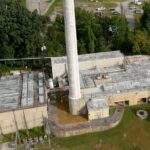
The Summit supercomputer at Oak Ridge National Laboratory remains the fastest supercomputer in the United States and the second most powerful in the world.
Summit, an IBM system, was the world’s most powerful supercomputer from June 2018 to November 2019, when the U.S. Department of Energy had the two fastest systems in the world.
DOE still has two of the three fastest supercomputers, Summit at ORNL and Sierra at Lawrence Livermore National Laboratory in Livermore, California. And it has three of the top five systems in the world. DOE has a new supercomputer, Perlmutter, ranked at number five. It’s at the National Energy Research Scientific Computing Center at the Lawrence Berkeley National Laboratory, in Berkeley, California. Perlmutter was the only new system in the top 10 in the semiannual TOP500 list released Monday.
Summit was bumped from the top spot on the TOP500 list by a Japanese supercomputer, Fugaku, in June 2020.
Fugaku, which is in Kobe, Japan, remained in the top spot on the TOP500 list released in November and again on the list released Monday. The TOP500 list uses a benchmark test to rank the world’s most powerful supercomputers.
Fugaku has been the fastest system on three consecutive lists as computer systems push toward the next frontier, known as exascale computing. ORNL is working on an exaflop system named Frontier that is expected to be the world’s fastest when it debuts, possibly this year.
Fugaku is a system co-developed by Riken and Fujitsu. It performed at 442 petaflops on the benchmark test, the same as in November. The performance is about three times better than Summit’s, according to the TOP500 list. Summit performed at 148.8 petaflops.
The TOP500 list said Fugaku’s peak performance is actually above an exaflop in single or further reduced precision, which is often used in machine learning and AI (artificial intelligence).
“Such an achievement has caused some to introduce this machine as the first ‘exascale’ supercomputer,” the list said. Fugaku has demonstrated this level of performance on a new benchmark test, recording two exaflops, the list said.
A petaflop is a quadrillion floating-point operations per second. Exaflops are a quintillion calculations per second.
Supercomputers are room-sized systems that can cost hundreds of millions of dollars. In the United States, they are used for scientific research and for work on nuclear weapons, among other uses.
The fourth most powerful supercomputer remained unchanged on the list released Monday. It was the Sunway TaihuLight supercomputer in China. Sunway TaihuLight is a former number one system installed at the National Supercomputing Center in Wuxi.
Perlmutter’s debut at number five on Monday bumped Selene, which is installed at NVIDIA Corporation, down to number six.
That pushed a former top supercomputer in China, Tianhe-2A (Milky Way-2A), down to number seven from the sixth spot in November. Tianhe-2A is a system developed by China’s National University of Defense Technology and deployed at the National Supercomputer Center in Guangzhou.
Here is a summary of the systems in the Top 10, from the TOP500 list:
- Fugaku remains the number one system. It has 7,630,848 cores, which allowed it to achieve an benchmark score of 442 petaflops. This puts it three times ahead of Summit, the number two system in the list.
- Summit, an IBM-built system at the Oak Ridge National Laboratory in Tennessee, remains the fastest system in the United States and the number two spot worldwide with a performance of 148.8 petaflops on the benchmark test, which is used to rank the TOP500 list. Summit has 4,356 nodes, each housing two Power9 CPUs (central processing units) with 22 cores each and six NVIDIA Tesla V100 GPUs (graphics processing units), each with 80 streaming multiprocessors. The nodes are linked together with a Mellanox dual-rail EDR InfiniBand network.
- Sierra, a system at the Lawrence Livermore National Laboratory in California, is at number three. Its architecture is very similar to Summit’s. It is built with 4,320 nodes with two Power9 CPUs and four NVIDIA Tesla V100 GPUs. Sierra achieved 94.6 petaflops.
- Sunway TaihuLight, a system developed by China’s National Research Center of Parallel Computer Engineering and Technology and installed at the National Supercomputing Center in Wuxi, which is in China’s Jiangsu province, is listed at the number four position. It is powered by Sunway SW26010 processors and achieved 93 petaflops on the high-performance benchmark test, not far behind Sierra.
- Perlmutter at number five is new in the TOP10. It is based on the HPE Cray “Shasta” platform, and a heterogeneous system with AMD EPYC based nodes and 1,536 NVIDIA A100 accelerated nodes. Perlmutter achieved 64.6 petaflops.
- Selene, now at number six, is an NVIDIA DGX A100 SuperPOD installed at NVIDIA in the United States. The system is based on an AMD EPYC processor with NVIDIA A100 for acceleration and a Mellanox HDR InfiniBand as a network. It achieved 63.4 petaflops.
- Tianhe-2A (Milky Way-2A), a system developed by China’s National University of Defense Technology and deployed at the National Supercomputer Center in Guangzhou, China, is now listed as the number seven system with 61.4 petaflops.
- A system called “JUWELS Booster Module” is the number eight. The BullSequana system build by Atos is installed at the Forschungszentrum Juelich in Germany. The system uses an AMD EPYC processor with NVIDIA A100 for acceleration and a Mellanox HDR InfiniBand as a network similar to the Selene System. This system is the most powerful system in Europe, with 44.1 petaflops.
- HPC5 at number nine is a PowerEdge system build by Dell and installed by the Italian company Eni S.p.A. It achieved a performance of 35.5 petaflops using NVIDIA Tesla V100 as accelerators and a Mellanox HDR InfiniBand as a network.
- Frontera, a Dell C6420 system, is installed at the Texas Advanced Computing Center of the University of Texas. It is now listed at number 10. It achieved 23.5 petaflops using 448,448 of its Intel Xeon cores.
China still has the most systems on the TOP500 list, with 186. That’s down from 212 in the previous list.
The United States had 123 systems, up from 113.
Despite having fewer machines, though, the performances of the U.S. machines easily outstripped Chinese supercomputers, the TOP500 list said. The United States has an aggregate performance of 856.8 petaflops, while China’s machines produced a performance of 445.3 petaflops.
The TOP500 list is compiled by Erich Strohmaier and Horst Simon of Lawrence Berkeley National Laboratory, Jack Dongarra of the University of Tennessee in Knoxville, and Martin Meuer of ISC Group in Germany. It’s been compiled since 1993.
See Monday’s list here.
More information will be added as it becomes available.
Most news stories on Oak Ridge Today are free, brought to you by Oak Ridge Today with help from our advertisers, contributors, and subscribers. This is a free story. Thank you to our advertisers, contributors, and subscribers. You can see what we cover here.
Do you appreciate this story or our work in general? If so, please consider a monthly subscription to Oak Ridge Today. See our Subscribe page here. Thank you for reading Oak Ridge Today!
Alternatively, you can donate to support our work here. Thank you for your support!
Copyright 2021 Oak Ridge Today. All rights reserved. This material may not be published, broadcast, rewritten, or redistributed.





Leave a Reply